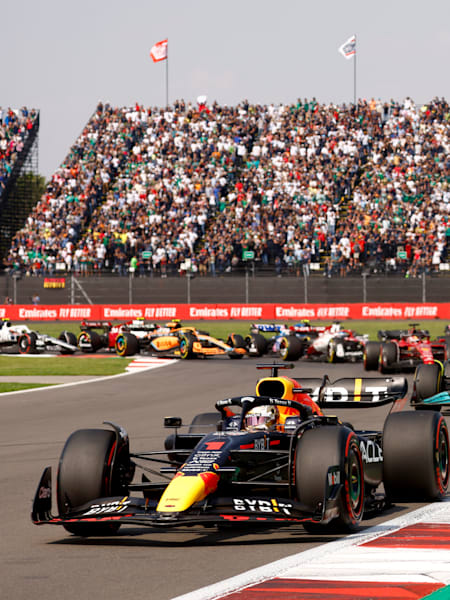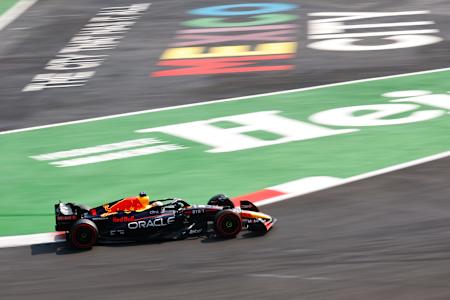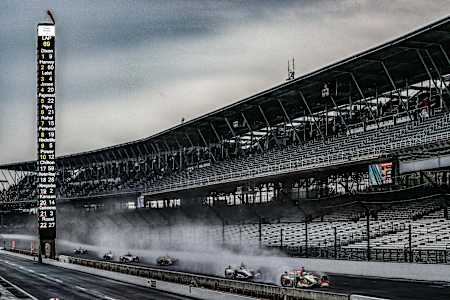Max Verstappen is one of the best Formula One drivers in the world. But if you ask him about racing in the IndyCar Series, he makes his fears very clear.
“It’s just the risk of a big crash is big, and of course, I know in F1 there also is risk of an impact, but when you hit a certain wall with 200-plus mph, it’s not enjoyable,” the two-time F1 World Champion said in a 2021 interview with NBC Sports.
“And that risk is higher in IndyCar, and especially if you would hit someone else and you go into the fence, there are plenty of examples where it doesn’t end well, or you end up being hurt. So for me, I love to watch it. I have a lot of respect for the drivers who do it, but I’m happy where I am.”
F1 and IndyCar have several similarities. Both are elite open-wheel, single-seat racing championships that employ some of the best drivers in the world. However, what makes these two series stand out is the differences between them. In this article, we will go over some of those differences and give some general examples to paint a better picture.
01
The Tracks
In that same interview with NBC Sports, Verstappen said, “I’m of course happy to be in Formula One, because I’m not personally a big fan of ovals. The street tracks and road courses are good, but nah, I would not be a big fan of oval racing myself.”
And that’s one of the main differences between F1 and IndyCar.
While they both race on the road/street courses, only IndyCar races on oval circuits. The 2022 IndyCar Series hosted five races on four oval tracks.
02
The Locations
The 2022 IndyCar Series only hosted races in the United States and Canada, while the 2022 F1 World Championship hosted races on five continents. Of course, this means that they have different notable races. Here are some quick facts on that.
IndyCar series quick stats:
- Number of tracks: 45 tracks
- Types of tracks: 24 ovals, 10 road courses, 10 street, 1 combined road
- Countries: USA & CA
- Average Length of tracks: 350 miles
Indycar notable races
Indy 500
- Location: Indianapolis, Indiana
- Length: 500 miles or 200 laps of the 2.5 mile oval
- Fast Fact: Starting field expands to 33 drivers, opens space for guest drivers from other racing circuits like Formula One
Grand Prix of Road America
- Location: Elkhart Lake, Wisconsin
- Length: 222 miles or 55 laps of the 4.0 mile oval
- Fast fact: Home to the longest track on the circuit
F1 quick stats
- Number of circuits: 75 worldwide, 40 with FIA grade to host F1
- Types of circuits: street circuits, road circuits, race circuits, hybrid circuits
- Countries : 34, including: Spain, France, Japan, Italy, Germany, USA,
- Average Length of tracks: 190-192 miles
F1 notable races
British Grand Prix
- Location: Silverstone, UK
- Length: 190 miles or 52 laps of the 3.66 mile circuit
- Fast Fact: Tied with the Italian Grand Prix for the most installments held (73)
Italian Grand Prix
- Location: Monza, Italy
- Length: 190 miles or 53 laps on the 3.6 mile circuit
- Fast Fact: Monza has hosted the most Formula One Grands Prix, with 72 races hosted
03
Cars
While the cars in the IndyCar Series and F1 World Championships may look similar, they are vastly different and have vastly different specifications.
The cars in IndyCar are almost identical. They use the same chassis and aerodynamic kit, with the engines coming from either Chevrolet or Honda. Everything else racing teams build and develop to give themselves an edge in races.
F1, on the other hand, has a distinct car design from each of its ten participating racing teams, while the power units are built by Ferrari, Red Bull, Renault or Mercedes.
As far as speed goes, F1 cars can maneuver around tracks faster, but IndyCars have a higher top speed. Indy cars can hit speeds upwards of 240 mph during a race, while F1 cars max out at around 220 mph.
When it comes to driver safety, F1 uses the Halo to protect its drivers from head injury. The IndyCar Series uses a mix of both the Halo and a Red Bull-developed “aeroscreen” to protect its drivers from head trauma from flying debris.
An additional key difference between how the cars are constructed is that F1 cars have power steering, while IndyCar Series cars do not. Because of this, it is much harder to steer in the IndyCar Series, making it a lot more physically taxing on the drivers.
04
Schedule and Point System
The IndyCar and F1 season run at about the same time.
The 2022 IndyCar season was 17 races long, starting in late February and ending in mid-September; the 2022 F1 World Championship was 22 races long, starting in mid-March and ending in mid-November.
As we mentioned earlier, IndyCar currently doesn’t have any races outside the North American continent, while F1 races are held across five different continents and 20 different countries. This restricts how much F1 can expand as far as venues and courses, with so many moving parts across so many different locations over such a long season already being enough of a challenge.
The formats of the driver fields are very different as well. Every single F1 race starts with 20 drivers, while IndyCar races can have as few as 24 starters and as many as 33 starters (for the Indy 500). Because of this, F1 and the IndyCar Series have two very complex and distinct scoring systems.
F1 Grand Prix of Brazil on November 13, 2022 in Sao Paulo, Brazil
© Jared C. Tilton/Getty Images/Red Bull Content Pool
In F1, the points system for placement works like this:
- 1st place: 25 points
- 2nd place: 18 points
- 3rd place: 15 points
- 4th place: 12 points
- 5th place: 10 points
- 6th place: 8 points
- 7th place: 6 points
- 8th place: 4 points
- 9th place: 2 points
- 10th place: 1 point
- 11th-20th place: 0 points
One point is added to the driver with the fastest lap if that driver also finishes in the top ten of that race.
In 2021, F1 introduced sprint qualifying at select tracks over the course of a season (for 2022, it happened at the Emilia Romagna Grand Prix, Austrian Grand Prix and São Paolo Grand Prix), in which drivers engage in a 100km race around the track. Eight points are given to the sprint winner, with every position behind them receiving one fewer point. Positions 9 through 20 gained no points.
The IndyCar series at the Indy Grand Prix on May 10, 2019
© Dutch Photo Agency / Red Bull Content Pool
In IndyCar, the points system for placement works like this:
- 1st place: 50 points
- 2nd place: 40 points
- 3rd place: 35 points
- 4th place: 32 points
- 5th place: 30 points
- 6th place: 28 points
- 7th place: 26 points
- 8th place: 24 points
- 9th place: 22 points
- 10th-25th place: Starts at 10th place with 20 points, and every position back earns one fewer point down to 25th place with five points
- 26th-33rd place: 5 points
One point is added to the driver in the pole position (except at the Indy 500). One point is given to a driver for every lap they are in leading position, with an additional two points going to the driver who led the most laps at the race.
The Indy 500, however, is a special case. At the Indy 500, 12 points are awarded to the driver that qualified in the pole position, with every position behind them receiving one fewer point. Positions 13 through 33 gain no points from qualifying. The Indy 500 is also a double-point event, meaning that any point total that a driver or team would gain normally is doubled. For example, if a driver qualified in 15th but finished fifth without leading any laps, they would win 60 points instead of the standard 30.
Conclusion
The F1 World Championships and the IndyCar Series are the top two open-wheel, single-seater driving championships in the world. While the racing that Pierre Gasly and Will Power do may look the same, the truth is that the two are vastly different! Just ask two-time F1 World Champion Fernando Alonso, who attempted the Indy 500 three times between 2017 and 2020 and finished no better than 21st.











